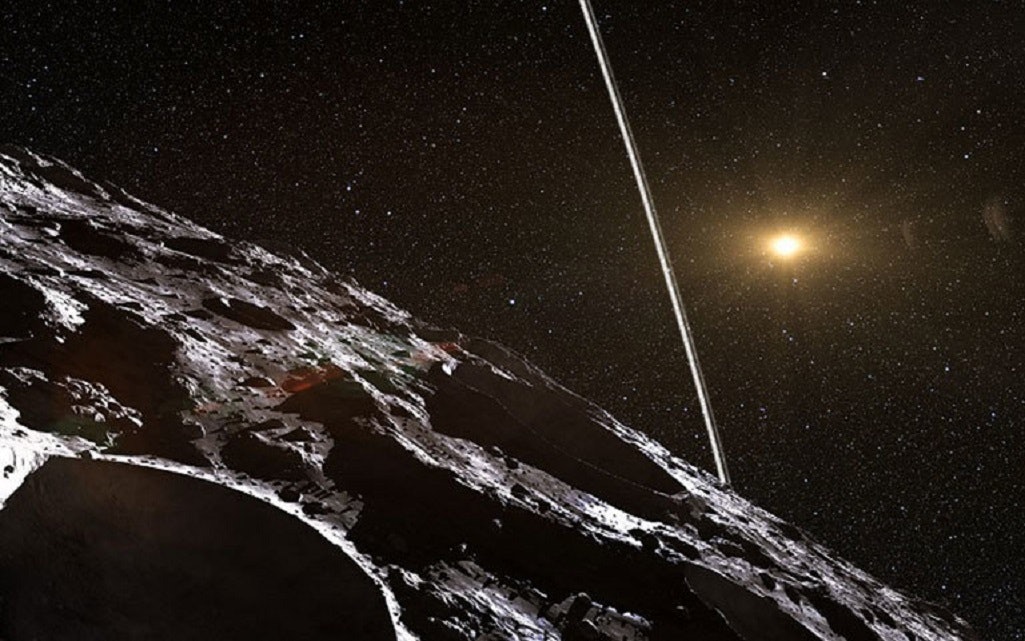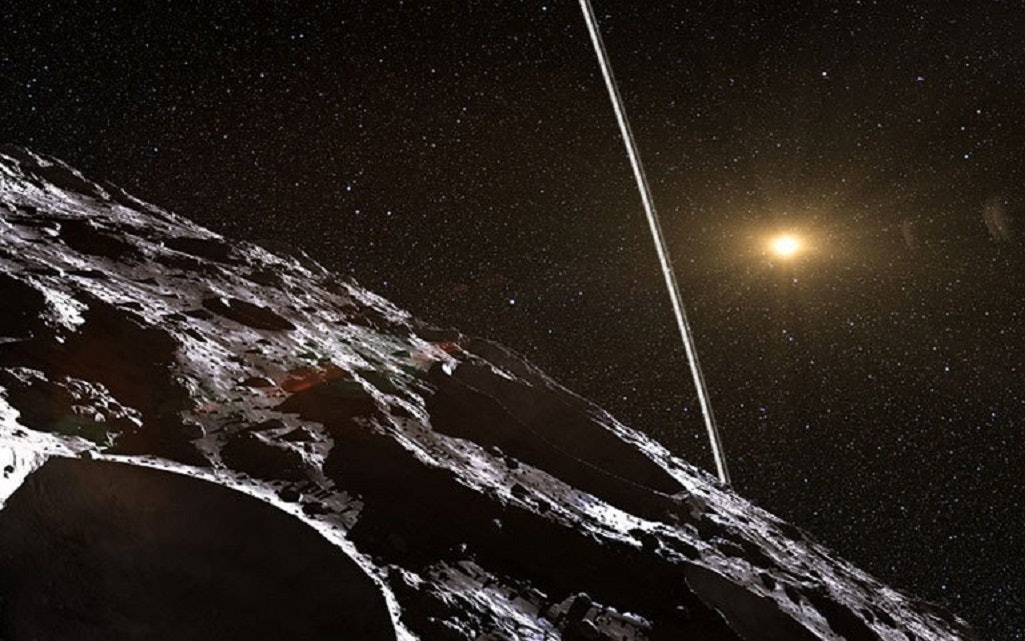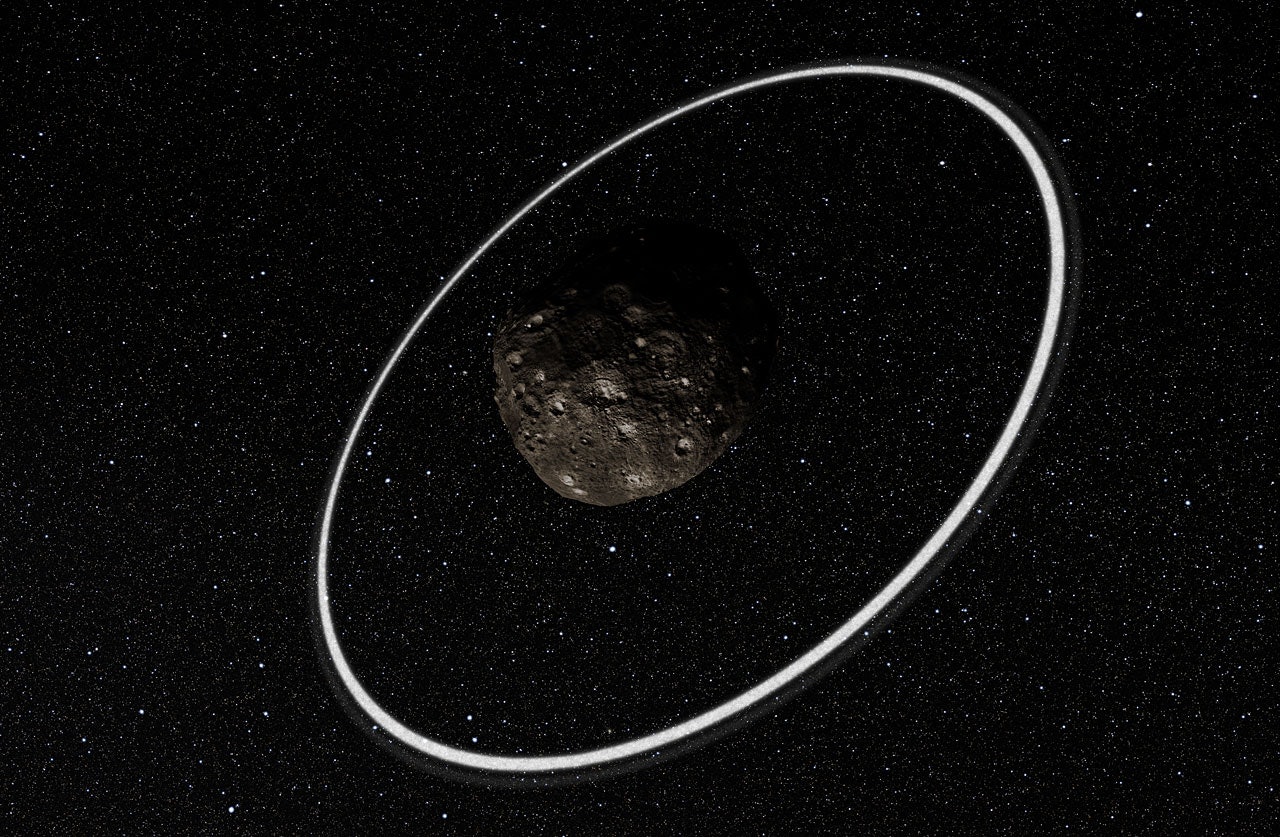
A handful of planets in our Solar System have rings: Jupiter, Saturn, Uranus, and Neptune, which most people know. But there are a handful of other objects in our neighborhood that have rings around them, and the James Webb Space Telescope (JWST) recently caught a glimpse of one of the ring systems in unprecedented detail.
Chariklo is an icy asteroid that orbits in the vast space between the paths of Neptune and Uranus, and it’s tiny: about 160 miles (250 kilometers) wide. But it sports at least two narrow, finely-wrought rings. That discovery startled astronomers a decade ago, and JWST recently helped shed more light on it.
What’s new — In October 2022, in the outer Solar System, a tiny asteroid called Chariklo passed between JWST and a distant star with the unwieldy name Gaia DR3 6873519665992128512. A team of astronomers led by Pablo Santos-Sans of the Instituto de Astrofísica de Andalucía used JWST’s NIRCam instrument to record the moment that the star’s light dimmed ever so slightly, twice in rapid succession — and then did it again. NIRCam had just watched the shadow of the rings blocking light from the star.
A short time later, another team of astronomers led by Dean Hines of the Space Telescope Science Institute pointed JWST’s Near Infrared Spectrometer (NIRSpec) instrument at Chariklo to measure the faint reflection of sunlight off the asteroid and the rings. Different molecules absorb and reflect different wavelengths of light, so by separating the sunlight reflected from Chariklos into the individual wavelengths that make it up, Hines and his colleagues can read the chemical fingerprints of the asteroid and its delicate rings.

It’s no real surprise that Hines and his team spotted ice in the spectrum of light reflected by Chariklos and its rings. Charikos makes its home in our Solar System’s equivalent of the Arctic Circle, after all, and it’s a type of asteroid called a Centaur: asteroids with an icy makeup similar to comets.
What is surprising is that the ice appeared to be crystalline, meaning its molecules are all lined up in a neat, orderly lattice structure. Nearly all of the frozen water we see here on Earth is crystalline ice, but astronomers didn’t expect to find it on the surface of an asteroid in the outer Solar System, exposed to constant bombardment by cosmic rays. Those cosmic rays tend to mess up the orderly structure of crystalline ice, turning it into what’s called amorphous ice.
According to Hines, “Detection of crystalline ice indicates that the Chariklo system experiences continuous micro-collisions that either expose pristine material or trigger crystallization processes.”

Here’s the background –—Chariklo holds two records at once: it’s the largest of the Centaur asteroids, and it’s the smallest object in our Solar System with rings, which is why astronomers were so shocked when they discovered the pair of rings around Chariklo in 2013.
Until then, everything we knew about the physics of how planets’ rings form said that a tiny little “minor planet” like Chariklo just didn’t have the gravity to maintain a ring system for very long. Within a few million years, the particles of ice and dust that make up the rings should either drift off into space, fall into the surface of Chariklo, or coalesce into a moon. So either they’re a very recent decorating choice (bold move, Chariklo), or they’re a hint that Chariklo also has at least one small moon whose gravity helps keep the rings in shape.
The rings are thin, but the material in them seems to be densely packed, and they form wide circles around the asteroid: about 250 miles (400 kilometers) from its surface. You could fit a second Chariklo in that space with room to spare. They’re probably made of a mix of ice and dust, which may be debris from another asteroid that crashed into Chariklo (and got the worse end of the confrontation) sometime in the asteroid’s unknown past.
We know that asteroids can have moons, like asteroid Ida and its little buddy Dactyl, or Double Asteroid Redirection Test target Didymos and its adorable moonlet Dimorphos. And Chariklo probably isn’t the only asteroid out there with a collection of rings; if it can happen once, it’s probably happened more than once. And some astronomers have already found evidence that asteroid Chiron — also one of the Centaurs, which may or may not be a coincidence — might also have a pair of rings.

What’s next — The actual visuals from these latest JWST observations aren’t especially stunning, because Chariklo is two billion miles away, and its rings are very thin and very far from its center, so even JWST’s powerful instruments can’t get an actual photograph of them. The best astronomers can do is measure the dip in light when the rings cross in front of a background star, called an occultation. Santos-Sans and his colleagues aren’t even sure yet whether NIRCam could see enough detail to help astronomers tell the two rings apart, or whether they appear as a single line. But there’s still a lot of information hidden in those brief flickers of shadow.
Graphs of the data will show exactly which wavelengths of light the rings blocked, and at what point in the occultation it happened. From those clues, Santos-Sans and his colleagues hope to learn about the sizes, colors, and chemical makeup of the particles in the rings, as well as the thickness of the rings themselves.
“We hope to gain insight into why this small body even has rings at all, and perhaps detect new, fainter rings,” Santos-San says in a recent press release.
Like Santos-San’s team, Hines and his colleagues aren’t yet sure whether they’ll be able to separate the light reflected off Chariklo’s surface from the light reflected off its rings — this time. Future observations should help them tell whether there’s a difference in the material that makes up the asteroid and its rings.
“By observing Charon with Webb over several years, as the viewing angle of the rings changes, we may be able to isolate the contribution from the rings themselves,” says University of Central Florida astronomer Noemi Pinillia Alonso, who led the spectroscopic observations for Hines and his colleagues’ study.
!["[T]he First and Fifth Amendments Require ICE to Provide Information About the Whereabouts of a Detained Person"](https://images.inkl.com/s3/publisher/cover/212/reason-cover.png?w=600)






